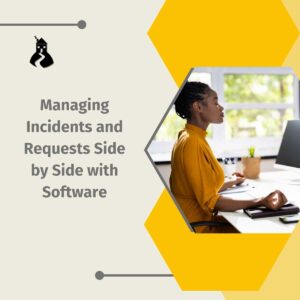
Figuring out whether a customer inquiry is an incident, or a request isn’t always straightforward. Having the flexibility to seamlessly switch between the two and log them within the same framework is beneficial. With House on the Hill software, you can tailor the workflow by simply adjusting the category. This ensures that the logging process aligns with either an Incident or Request. Alternatively, if you manage these processes separately, you can easily move calls between folders within the Support Desk platform. This allows for swift reclassification, ensuring calls are directed to the right folder using the Move button.
Self-Service Portal: Tailoring Forms for Efficiency
Managing Incidents and Requests with House Forms within the Support Desk enables the creation of customised forms for different types of Incidents and Requests. This ensures that all necessary information is captured when customers log their inquiries on the web self-service portal. Whether it’s equipment requests, password resets, or starter forms, having unique Incident and Request forms empowers customers to choose the appropriate one for their needs. On the other hand, you may opt for a more streamlined approach by offering a single generic form for logging both Incidents and Requests, simplifying the process for customers while still helping efficient handling by Service Desk Agents.
Managing Incidents and Requests with different SLAs
Service Level Agreements (SLAs) for Incidents may differ significantly from those for Requests. Whether managing them separately or within the same folder, unique SLAs can be set up for each type of inquiry. These SLAs can be set based on various parameters such as Type, Sub-Type, and other call categories. Selecting a specific Incident or Request can automatically trigger the proper Priority, Response, Warning, and Action times, with relevant email templates dispatched to concerned parties.
Enhancing Help Desk Communication
The essence of help desk software lies in its ability to help users promptly and efficiently. Therefore, ensuring that customers can easily access the help desk to monitor the progress of their logged issues and requests is paramount. Lengthy wait times are detrimental to everyone involved. To provide best service to customers and ensure seamless communication, consider the following strategies:
Self-Service Portal for Managing Incidents and Requests: The Support Desk software offers a web-based customer portal where users can track the progress of their tickets. Custom forms tailored to different types of issues and requests streamline the data collection process.
Managing Incidents and Requests FAQs: Dedicated FAQ sections on the customer portal enable users to access helpful guides or step-by-step processes for resolving common issues. Users can rate the usefulness of KnowledgeBase articles, providing valuable feedback.
Service Updates: Allow customers to subscribe to service updates to receive alerts about online, offline, or impacted services. Notify subscribers via email if services are offline or affected, keeping them informed about ongoing issues.
Newsfeed/Noticeboard: Maintain a noticeboard or newsfeed to share company announcements and updates, including scheduled downtime or service interruptions.
Live Chat: Incorporate a live chat function into the help desk for instant communication with online agents. Automatically generate tickets from chat transcripts, ensuring seamless documentation of customer interactions.
Automatic Email Notifications: Set up automated email notifications to update customers on the progress of their calls at various milestones, such as ticket creation, assignment to agents, or resolution.
Scheduled Reports: Send regular help desk report packs to customers, providing transparency regarding service desk performance. Schedule reports to run daily, weekly, or monthly according to preference.
Telephony Integration: Integrate the service desk system with telephony to automatically detect incoming calls and launch tickets pre-populated with customer details, streamlining the support process.





